Blackpowder snake shot loads.
There has been an ongoing discussion of the practicality of loading a cap & ball revolver with birdshot for defense against poisonous snakes. My speculation on the subject was that the limited chamber capacity would just not afford room for an effective combination of powder, wads and shot. But why speculate, why not conduct a simple little test? I chose to use my replica 1860 Colt Army .44 caliber revolver.
I don't suggest this to be the definitive work on the subject but just to give an idea of the capabilities of a .44 cap & ball revolver loaded with #8 birdshot.
First to decide on a powder charge I arbitrarily chose 20 grains as the smallest charge I believed likely to produce enough velocity to drive a shot pellet through a snake at close range. It might be possible that a lighter charge would be adequate but that is one thing the test was intended to determine.
With 20 grains weight of Goex 3fg settled into one chamber I then seated a 1/8" thick wad atop the powder and compressed it very heavily. I then poured #8 birdshot pellets atop the wad to fill the chamber just below the mouth, leaving room for another wad to hold the shot in place. I then dumped that shot onto my powder scale and found it balanced at 110 grains. I didn't bother to count the pellets but charts show #8 shot should run 410 pellets to one ounce so 110 grains weight would represent about 103 pellets, plus or minus a few. Coincidentally I found this to be an "equal volume load", One can use Lee powder dipper #1.3CC to measure out both 20 grains of powder and 110 grains of shot.
Here are the components
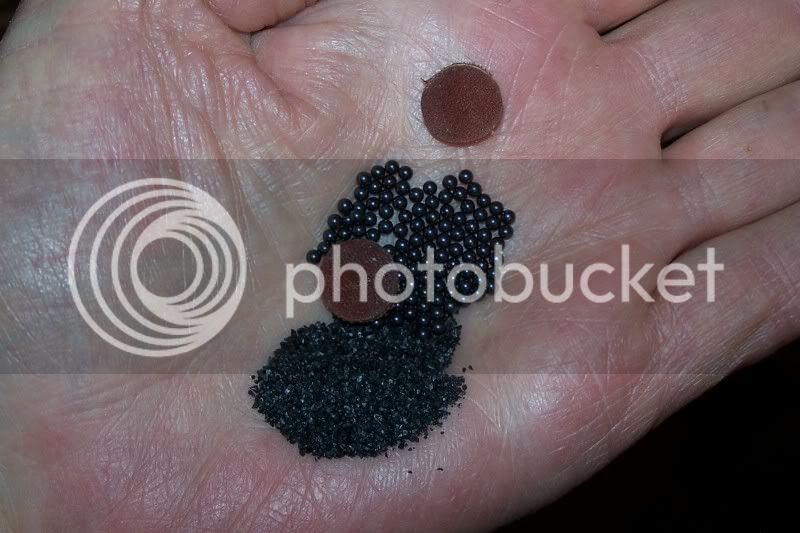
I charged three chambers with that load, 20 grains powder and 110 grains #8 shot. I seated the top wad with very heavy compression and sealed it to the cylinder with clear nail polish to secure it against being unseated by recoil. I charged two more chambers with 20 grains of powder and a .457" diameter round ball topped off with deer tallow to seal the chamber.
The loaded cylinder then looked like this, with one chamber left empty for safe carry.
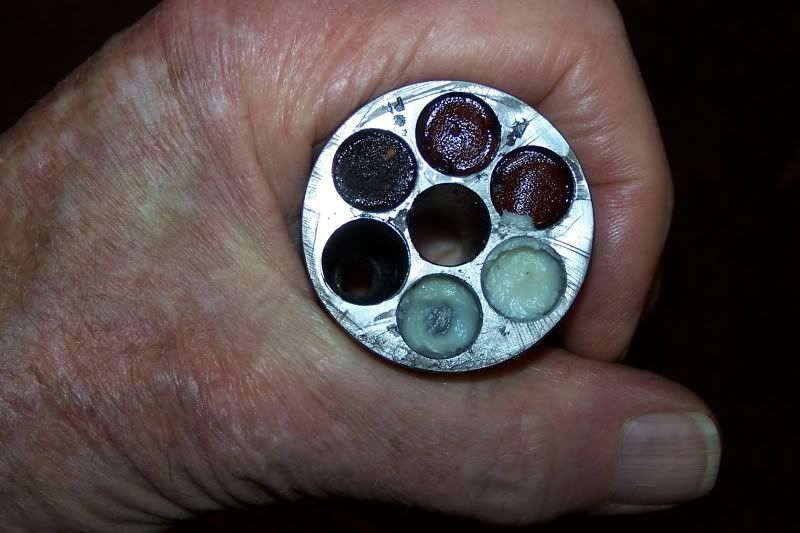
I was curious as to the velocity of this load but know from past experience that a single stray pellet can destroy a chronograph so I thought I would chronograph the ball loads and just assume the shot loads would have a similar velocity. The balls over 20 grains of Goex 3fg clocked only 612 fps. My .410 pistol with 10" barrel shows a bit over 900 fps for 3" shotshells. That velocity difference means each pellet from the .410 carries 2 1/4 times the energy of the .44 pellets.
I also wanted to test the penetration of this load but not having any snakes to serve as targets I elected to shoot some newspaper and compare penetration of the blackpowder load to penetration of a modern .410 shotshell. The pellets from the .44 penetrated only about 1/4" of newspaper. Those from the .410 went nearly twice as deep at about 7/16".
This is the .44 snake load at 10 feet. The entire pattern of 100+ pellets clustered in a circle of about 8" diameter. Clearly the snake would be hit many times and if the penetration is adequate that would be one dead snake.
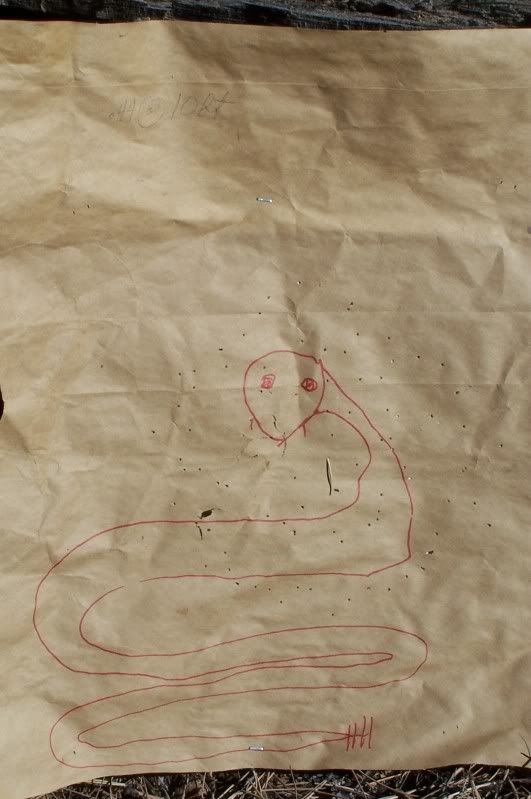
Below is the .44 snake load at 20 feet, certainly not dependable at all. I also fired a target at 30 feet and suffice to say only 23 pellets struck anywhere on the 14x18" paper.
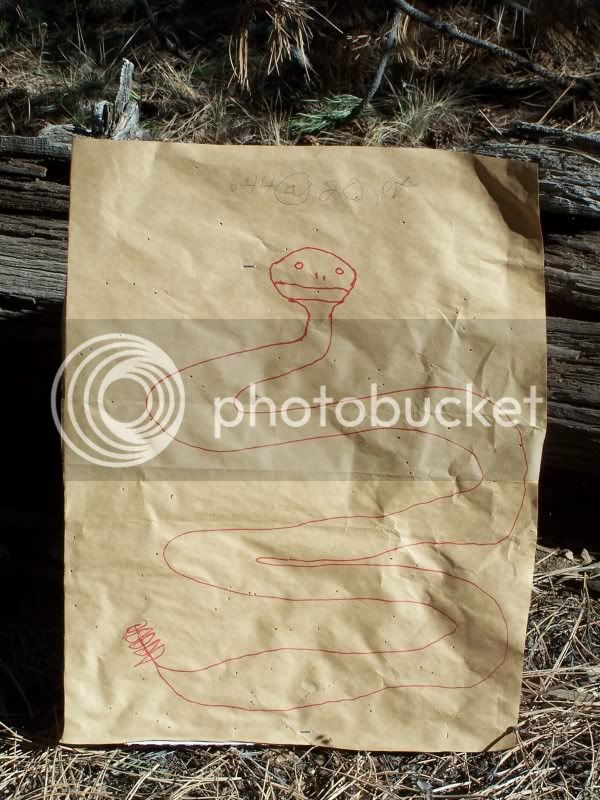
And for comparison, below is a real snake load, the 3" .410 shotshell at 30 feet.
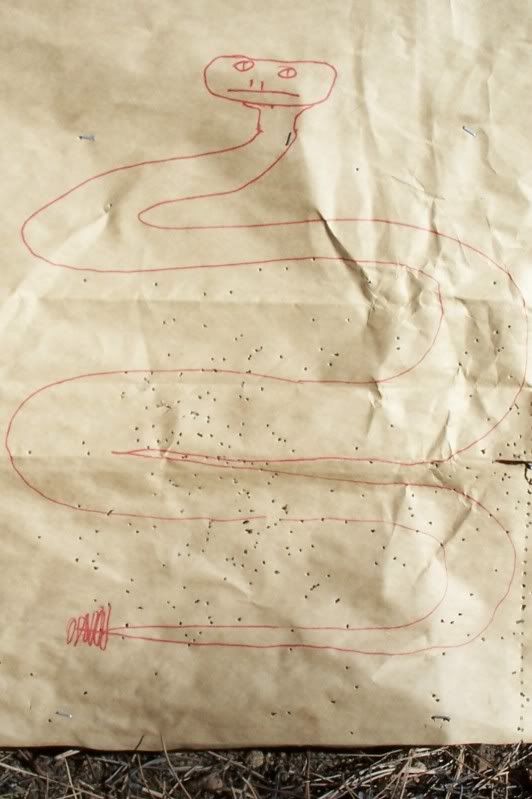
All in all the .44 cap & ball did better than I had expected and would probably be deadly at 10-12 feet if the pellets have sufficient penetration, a matter of which I am uncertain.
There has been an ongoing discussion of the practicality of loading a cap & ball revolver with birdshot for defense against poisonous snakes. My speculation on the subject was that the limited chamber capacity would just not afford room for an effective combination of powder, wads and shot. But why speculate, why not conduct a simple little test? I chose to use my replica 1860 Colt Army .44 caliber revolver.
I don't suggest this to be the definitive work on the subject but just to give an idea of the capabilities of a .44 cap & ball revolver loaded with #8 birdshot.
First to decide on a powder charge I arbitrarily chose 20 grains as the smallest charge I believed likely to produce enough velocity to drive a shot pellet through a snake at close range. It might be possible that a lighter charge would be adequate but that is one thing the test was intended to determine.
With 20 grains weight of Goex 3fg settled into one chamber I then seated a 1/8" thick wad atop the powder and compressed it very heavily. I then poured #8 birdshot pellets atop the wad to fill the chamber just below the mouth, leaving room for another wad to hold the shot in place. I then dumped that shot onto my powder scale and found it balanced at 110 grains. I didn't bother to count the pellets but charts show #8 shot should run 410 pellets to one ounce so 110 grains weight would represent about 103 pellets, plus or minus a few. Coincidentally I found this to be an "equal volume load", One can use Lee powder dipper #1.3CC to measure out both 20 grains of powder and 110 grains of shot.
Here are the components

I charged three chambers with that load, 20 grains powder and 110 grains #8 shot. I seated the top wad with very heavy compression and sealed it to the cylinder with clear nail polish to secure it against being unseated by recoil. I charged two more chambers with 20 grains of powder and a .457" diameter round ball topped off with deer tallow to seal the chamber.
The loaded cylinder then looked like this, with one chamber left empty for safe carry.

I was curious as to the velocity of this load but know from past experience that a single stray pellet can destroy a chronograph so I thought I would chronograph the ball loads and just assume the shot loads would have a similar velocity. The balls over 20 grains of Goex 3fg clocked only 612 fps. My .410 pistol with 10" barrel shows a bit over 900 fps for 3" shotshells. That velocity difference means each pellet from the .410 carries 2 1/4 times the energy of the .44 pellets.
I also wanted to test the penetration of this load but not having any snakes to serve as targets I elected to shoot some newspaper and compare penetration of the blackpowder load to penetration of a modern .410 shotshell. The pellets from the .44 penetrated only about 1/4" of newspaper. Those from the .410 went nearly twice as deep at about 7/16".
This is the .44 snake load at 10 feet. The entire pattern of 100+ pellets clustered in a circle of about 8" diameter. Clearly the snake would be hit many times and if the penetration is adequate that would be one dead snake.

Below is the .44 snake load at 20 feet, certainly not dependable at all. I also fired a target at 30 feet and suffice to say only 23 pellets struck anywhere on the 14x18" paper.

And for comparison, below is a real snake load, the 3" .410 shotshell at 30 feet.

All in all the .44 cap & ball did better than I had expected and would probably be deadly at 10-12 feet if the pellets have sufficient penetration, a matter of which I am uncertain.






